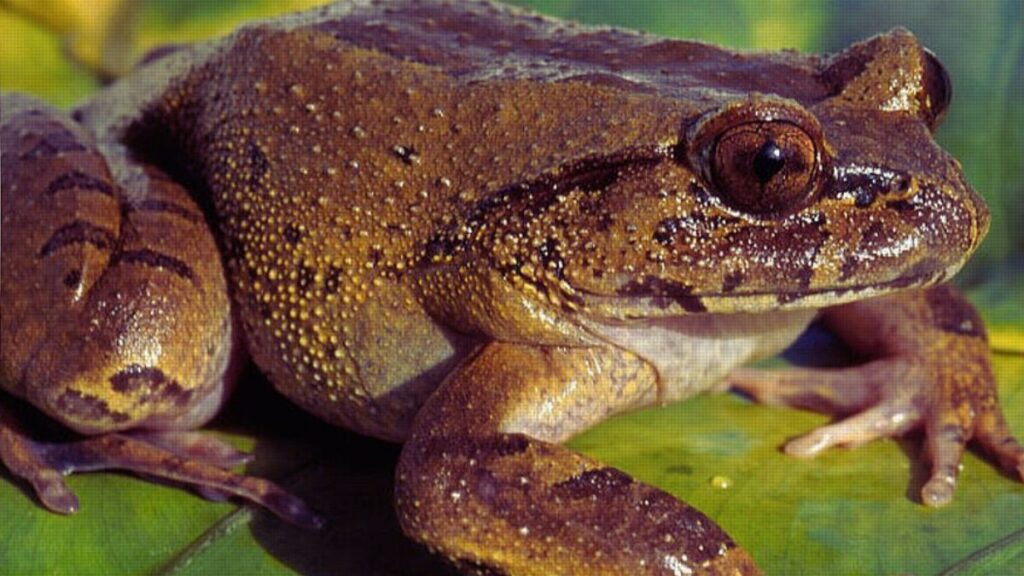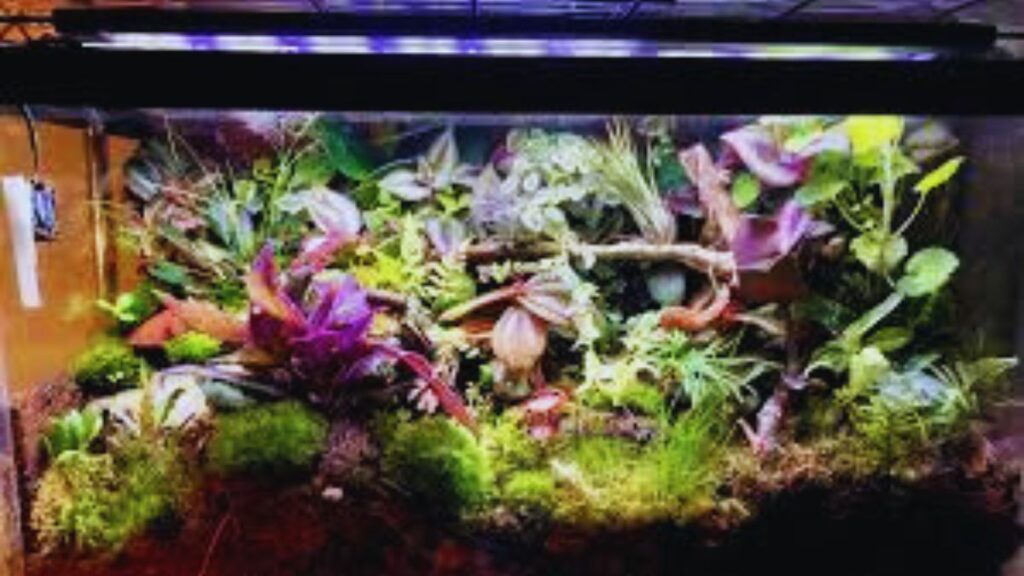Hairy frogs are one of the most popular monotypic Central African frogs which are known for their hair-like structure on the body and thighs of the breeding male. These frogs are also known as “Horror frogs” or “Wolverine frogs”. But many amphibian lovers often doubt if hairy or wolverine frogs are good pets. Let’s dive in:

Table of Contents
Everything About Hairy Frogs (wolverine frogs):
Geographic Range:
Hairy frogs are mainly native to Central Africa. It is commonly found in Cameroon, Congo, Equatorial Guinea, Gabon, Nigeria, Chad, Niger, Sudan, Ethiopia, Uganda and Angola.
Habitat:
Wolverine frogs prefer a warm and moist habitat with water sources nearby. The frogs live in agricultural land near a fast-flowing river as they breed in the river. These frogs are generally wild and generally found in forest areas.
Physical Description:
Sexual dimorphism is present in hairy frogs as males are slightly larger than females. Males are 10–13 cm (4–5 in) long from snout to vent, whereas females are a little shorter (8-11 cm or 3-4.5 in).

Wolverine frogs have a large, broad, and stubby head with a short rounded snout. Males have a pair of vocal sacs along with three short ridges of small black spines on the inner surface.
These frogs are known as hairy frogs because the breeding male develops hair-like dermal papillae on their body that extend to flanks and thighs.
It is believed that the hair is made up of arteries and a mass of thin strands of skin replete with blood vessels that help absorb oxygen by increasing the surface area. The hair helps the male to stay with eggs for an extended period.
Poisonous:
Hairy frogs, also known as horror frogs are neither poisonous nor harmful to humans. These frogs have a different and unique defense mechanism that helps them to protect from predators but wolverine frogs have no gland that secrete toxins.
Behaviour:
Horror frogs are nocturnal and terrestrial by nature. These frogs often go hunting at night and during day time they rest inside underground burrows. The frogs return to the water and lay eggs on the rock in the flowing streams.
Defence Mechanism:
Hairy frogs (Horror frogs) have a wonderful defence mechanism by which they can produce an arsenal of sharp, curved claws that snap out of their toes like switchblades from their flex of a foot muscle. They are not true claws as these are not made up of keratin but bones.

There is also a little bony nodule nestled in the tissue ahead of its fingertip. When sheathed, the claws anchored to the nodule with hard strands of collagen.
When someone grabs or attacks the frogs, they break the nodule connection to make the claws sharp through the skin. A few violent kick with those claws can retreat any opponent and even can harm humans. People in Cameroon who hunt the frogs, use spears and machetes to protect themselves from the attack of the frogs. Their claws can lead to serious bleeding in humans.
The claws eventually vanish and the toe wounds heal when their need is over. If the blades are needed again, horror frogs follow the same process to regenerate them.
Vocalization:
The wolverine frogs have a unique vocalization that sounds like a little barking dog. These frogs only use the sound to attract partners during mating season.
Physical Activities:
Hairy frogs are equally comfortable in the ground as well as in water. The frogs can jump, hog, as well as swim with equal expertise.
Diet:
The tadpoles are muscular and they are completely carnivorous since birth. Adults feed on slugs, molluscs, spiders, beetles, grasshoppers, cockroaches, and other invertebrates.
Predators:
Humans are horror frogs’ main predators. However, these frogs don’t have many natural predators but snakes, prey birds, lizards, small mammals, squirrels, and larger fishes are their notable enemies.
Conservation Status:
Hairy frogs are listed as “least concern” in the IUCN Red List of Threatened Species and also mentioned that the number of these species is decreasing in the wild.
Lifespan:
There is no concrete information available about the lifespan of horror frogs.
Are hairy frogs (Wolverine frogs) good pets for families?
Hairy/horror frogs can be a unique choice of pets for families but there is some concern associated with it. These frogs are not poisonous nor cause much trouble to the owner. But due to their sharp claws, Wolverine frogs can attack whoever tries to touch them and make them bleed.
Hence, if you are a beginner or you have little kids at your home, it is advisable to avoid having horror frogs as pets. But if you have some experience with other amphibians and know how to deal with frogs such as Pacman frogs, then you can easily deal with these frogs.
Hairy frogs require a specific environment closer to their native environment to thrive. Hence, being a pet owner, you need to be very careful to create their natural environment inside the enclosure, which could be costly as well.

Horror frogs don’t prefer to be touched by humans. Unnecessary touches give them stress and the frogs can attack even their owner. Hence, whenever you try to touch those frogs, wear thick gloves to protect your hands from their attack.
You cannot expect an emotional bond between you and your pet frogs like you expect from your pet dogs, cats, or rabbits. The relationship between you and your frogs will be similar to the food provider and consumer. However, you can notice their entertaining activities and also show your friends or families the unique defence mechanism of wolverine frogs.
How do you buy hairy frogs?
People in Cameroon and Congo often catch hairy frogs to consume and sell them in illegal pet markets. Those frogs are illegally trapped and disease-prone. Hence, if you really want to buy horror frogs, buy them from a reputed pet shop or a frog breeder. Or you can check online platforms too to purchase these frogs.
If you are planning to buy the frogs from an online platform, check their ratings, reviews, and policies before clicking the purchasing button. Don’t forget to ask for their proof of origin and health certificate before buying the Wolverine frogs.
The price of hairy frogs will vary from $60-$250 depending on their age, health condition, gender, availability, and your location. These frogs are generally costly compared to other frog species.
Requirement and care:
Hairy frogs require a specific environment to thrive that is similar to their native habitat.
Tank and Substrate:
A 10-gallon terrarium tank with a secure lid and proper ventilation system can be sufficient for each horror frog. 20-30% of the total area of the enclosure must be filled with dechlorinated water where the frogs can breed and the rest of the area should be covered with live or artificial trees and grasses.
You also need to provide them with a water dish where you can provide them with drinking water and food. It is better to use artificial plants inside the tank instead of live plants because artificial plants don’t generate waste like live plants. 50% of the water from the enclosure should be changed daily with fresh dechlorinated water.
Any substrate that can hold moisture will be suitable for horror frogs such as peat moss, sphagnum moss, coco fibre, cork bark, etc. Natural substrates are best because they allow you to plant live trees in it but artificial plants are also equally good.
Temperature, Light, and Humidity:

Horror frogs require a warm and moist environment to survive. You need to keep the temperature at 75-85°F to provide them with sufficient warmth. The humidity level also needs to be fixed between 60-70% at least. Additionally, like other frog species, wolverine frogs also need a 12-hour day and night circle to maintain their daily activities.
It is very important to keep an eye on the temperature or humidity level as overheating or overcooling the environment can harm the frogs. If the enclosure is cold, use heat lamps and heat mats to warm it up.
You can also use UVA/UVB bulbs to provide them with light and warm temperatures as well, but avoid overheating the enclosure.
To increase humidity, use a mist maker or fogger or simply sprinkle water in the enclosure multiple times a day to maintain the humidity level.
Food and Supplements:
How much food a hairy frog will consume completely depends on its age, sex, health condition, and appetite level. A mature horror frog can consume two to three gut-loaded mealworms every other day. But it is advisable to feed the tadpoles one gut-loaded mealworm per day to make them healthy.
You need to provide the frogs with a sufficient amount of dechlorinated water for drinking. The water should be changed daily and refilled with fresh dechlorinated water. Once a week, you need to dust their food in calcium and vitamin D3 supplements that make them stronger because the pet frogs don’t receive vitamin D from sunlight.
Cleaning and Handling:
Being an owner, you need to keep the enclosure clean and free from any waste. Regularly clean the water dish, waste food, and dead insects from the enclosure to prevent bacterial and fungal growth.
Additionally, you need to deep-clean the tank once a month with a mild disinfectant and rinse thoroughly with dechlorinated water. Don’t use any chemical substance that reacts with frog’s skin and makes them sick. Change the substrate only when it smells bad.
Unfortunately, hairy (horror frogs) don’t like to be touched by humans. If you touch them unnecessarily it makes them stress and annoy them. These frogs can even attack the pet owner and hence it is advised to wear thick gloves to prevent your hands from bleeding. Keep your kids away from the Wolverine frogs or they can harm your kids.
FAQs:
Can you keep two same species or different species of frogs with a Hairy frog?
It is never a good idea to keep a horror frog with another horror frog or with different species of frogs. If you keep a hairy frog with another species of frog, the stronger one will kill the weaker ones.
The hairy frogs also show cannibalism and hence the stronger frog will kill its own species. But if you decide to keep more than one hairy frog in a single container, ensure the frogs have enough distance between them.
References: Hairy frog on Wikipedia
Also Read: Are Greenhouse Frogs Good Pets For Families?
Also Read: Are Pixie Frogs (African Bullfrogs) Good Pets? Everything You Should Know Before Purchasing
Also Read: 5 Tips To Choose The Best Dog Foods For French Bulldogs